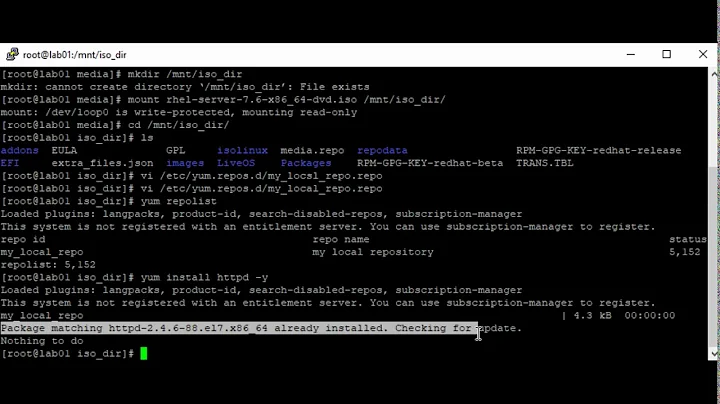How do I get yum to see updates to a local repo without cleaning cache?
Solution 1
You can run "yum clean expire-cache" which is much more efficient way to tell yum to check the repos. ... the other thing to do would be to change the metadata_expire value for the local repo. (see man yum.conf).
Solution 2
Try adding following line in /etc/yum.conf on Yum clients:
metadata_expire=1m
Following command shows you more info:
man yum.conf
FYI. CentOS 5 has the parameter commented out. CentOS 6.2 has 90m for the value.
Solution 3
yum clean metadata cleans up just the cached names and such, after which yum reloads its idea of what is available.
Related videos on Youtube
Matt
Updated on September 18, 2022Comments
-
Matt over 1 year
I have set up a local yum repository which I use to install test builds. For the testing purposes, my packages are versioned by
<svn version number>.<date>.<time>(e.g.12345.20110908.150404The trouble is, once I make a new RPM, copy it to the repository directory and run
createrepo $REPO_DIR, yum does not see the new RPM as being available.$ cd $REPO_DIR $ ls -1 repodata package-12345.20110908.150404-1.x86_64.rpm package-12345.20110908.174329-1.x86_64.rpm $ createrepo . # ...snip... $ rpm -q package package-12345.20110908.150404-1.x86_64 $ yum list --showduplicates package Installed Packages package.x86_64 12345.20110908.150404-1 @repo Available Packages package.x86_64 12345.20110908.150404-1 repoI can see the updates and grab them if I run
yum clean alland then re-fetch the metadata, but I think this just means I need to be doing something else from the repo, as I don't have to do that for other yum repos.How do I need to set up my local repository so that I only need to run
yum updatefrom the client without having to clean my yum cache? -
 slm about 11 yearsPlease read the question carefully. I believe he was looking for an alternative method where he didn't have to clear the cache.
slm about 11 yearsPlease read the question carefully. I believe he was looking for an alternative method where he didn't have to clear the cache. -
 jobwat about 11 yearsgod you're so right :|
jobwat about 11 yearsgod you're so right :| -
 Falcon Momot almost 10 yearsNope, in this case, the problem is certainly that it thinks the cache is still valid and doesn't check for updates.
Falcon Momot almost 10 yearsNope, in this case, the problem is certainly that it thinks the cache is still valid and doesn't check for updates. -
myroslav over 9 yearsIs there a way to expire-cache only specific repository?
-
James Antill over 9 yearsThe only easy way to do that is --disablerepo=* --enablerepo=myrepo,otherrepo ... although you can create an alias if it's something you'll do a lot.
-
 bgStack15 over 7 yearsI was able to update just one repository using this statement and another one:
bgStack15 over 7 yearsI was able to update just one repository using this statement and another one:yum --disablerepo=* --enablerepo=epel clean metadata -q; yum check-update --disablrepo=* --enablerepo=epel -q. I'll just make a bash function and be done with it! -
 jwm over 4 yearsThis is somewhat old, but I just ran into this. You can set this value for a single repository by editing the /etc/yum.repos.d/my.repo file.
jwm over 4 yearsThis is somewhat old, but I just ran into this. You can set this value for a single repository by editing the /etc/yum.repos.d/my.repo file.




